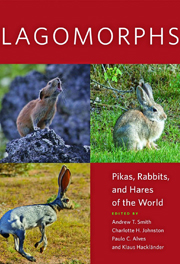Lagomorphs: Pikas, Rabbits, and Hares of the World

Andrew T Smith, Charlotte H Johnston, Paulo C Alves and Klaus Hackländer (Eds)
Johns Hopkins University Press, £66.50
Andrew Smith and his colleagues have produced an outstanding book that summarises the current knowledge of the world’s 92 species of lagomorphs in one reference volume. Drawing on the expertise of 82 specialists on lagomorphs, this is a truly comprehensive reference work that provides detailed, species-specific information as well as a review of the ecological role of lagomorphs.
Following introductory chapters on the evolution, systematics, introductions, diseases and conservation of pikas, rabbits and hares, detailed information is provided for each species. This includes scientific and common names, a contemporary range map and description, a detailed description of appearance together with morphological measurements, accompanied by high-quality colour photographs of most of the species.
Discussions of relevant palaeontological data, taxonomy and geographic variation follow, and are iterated for each species. Information on ecology, habitat, diet, behaviour, genetics and physiology, reproduction and development, as well as parasites and disease, are also included.
The book is written in a very accessible style, heavy with factual material, but presented in straightforward language and conveniently grouped under relevant headings. Information related to any one species is easy to find and presented succinctly. The discussions bring knowledge and understanding right up to date and are very much to the point without being over burdensome. As such, Lagomorphs is accessible to the general public as well as the scientific community.
This is, without doubt, a definitive reference work that will be useful to anyone with a serious interest in these animals, but particularly professional biologists, students at all levels and naturalists in general. There is such breadth of coverage that anyone working in fields that involve lagomorphs, such as conservation or biodiversity, will find use for this book.
Dr Alan Woollhead


